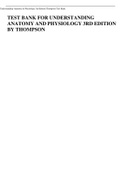Understanding Anatomy & Physiology 3rd Edition Thompson Test Bank
TEST BANK FOR UNDERSTANDING
ANATOMY AND PHYSIOLOGY 3RD EDITION
BY THOMPSON
,Understanding Anatomy & Physiology 3rd Edition Thompson Test Bank
Chapter 1: Orientation to the Human Body
Matching
Match the name of each organ system to its key components.
a. integumentary system g. nervous system
b. skeletal system h. endocrine system
c. muscular system i. circulatory system
d. lymphatic system j. digestive system
e. respiratory system k. male reproductive system
f. urinary system l. female reproductive system
1. Consists of stomach, small and large intestines, liver, and pancreas
2. Consists skin, hair, and nails
3. Consists of kidneys, ureters, urinary bladder, and urethra
4. Consists primarily of skeletal muscles
5. Consists of heart, arteries, veins, and capillaries
6. Consists of brain, spinal cord, nerves, and sense organs
7. Consists of ovaries, fallopian tubes, uterus, vagina, and breasts
8. Consists of pituitary gland, adrenals, pancreas, and thyroid
9. Consists of lymph nodes, lymphatic vessels, lymph, thymus, and spleen
10. Consists of the nose, pharynx, larynx, trachea, bronchi, and lungs
Match each term to its definition.
a. distal f. inferior
b. proximal g. anterior
c. medial h. posterior
d. lateral i. superficial
e. superior j. deep
11. Toward the back of the body
12. Farthest from the point of origin
13. Above
14. At or near the body’s surface
15. Toward the body’s midline
,Understanding Anatomy & Physiology 3rd Edition Thompson Test Bank
16. Closest to the point of origin
17. Toward the front of the body
18. Below
Match each term to its location on the body.
a. frontal i. buccal
b. deltoid j. cephalic
c. brachial k. lumbar
d. inguinal l. calcaneal
e. pectoral m. plantar
f. sternal n. pedal
g. digital o. tarsal
h. antecubital p. axillary
19. Arm
20. Lower back
21. Armpit
22. Heel
23. Fingers
24. Shoulder
25. Sole of the foot
26. Forehead
27. Chest
28. Front of elbow
29. Foot
30. Cheek
31. Groin
32. Ankle
Multiple Choice
Identify the choice that best completes the statement or answers the question.
33. Which organ system produces immune cells and has a role in fluid balance?
a. Integumentary system
b. Circulatory system
c. Endocrine system
d. Lymphatic system
,Understanding Anatomy & Physiology 3rd Edition Thompson Test Bank
34. Which organ system protects organs, allows for support and movement, and also plays a key role in
blood formation?
a. Circulatory system
b. Muscular system
c. Skeletal system
d. Nervous system
35. Which type of body tissue covers the body’s surface?
a. Epithelial
b. Connective
c. Muscle
d. Nerve
36. Bone, cartilage, and adipose tissue are all types of
a. epithelial tissue.
b. connective tissue.
c. muscle.
d. nerve tissue.
37. The type of plane that divides the body horizontally into upper and lower portions is called a
a. sagittal plane.
b. frontal plane.
c. transverse plane.
d. coronal plane.
38. Most illustrations that show the contents of the abdominal cavity use what type of plane?
a. Sagittal
b. Transverse
c. Horizontal
d. Frontal
39. Which of the following correctly describes the anatomical position?
a. Standing erect, facing forward, with arms outstretched
b. Standing erect with arms at sides, palms facing backward, face and feet facing
forward
c. Standing erect with arms overhead, face and feet facing forward
d. Standing erect with arms at sides and with palms, face, and feet facing forward
40. The dorsal cavity contains the
a. thoracic and abdominopelvic cavities.
b. cranial and spinal cavities.
c. mediastinum and pleural cavities.
d. abdominal and pelvic cavities.
41. The heart is located in the mediastinum, which is part of what cavity?
a. Thoracic cavity
b. Dorsal cavity
c. Spinal cavity
d. Cranial cavity




